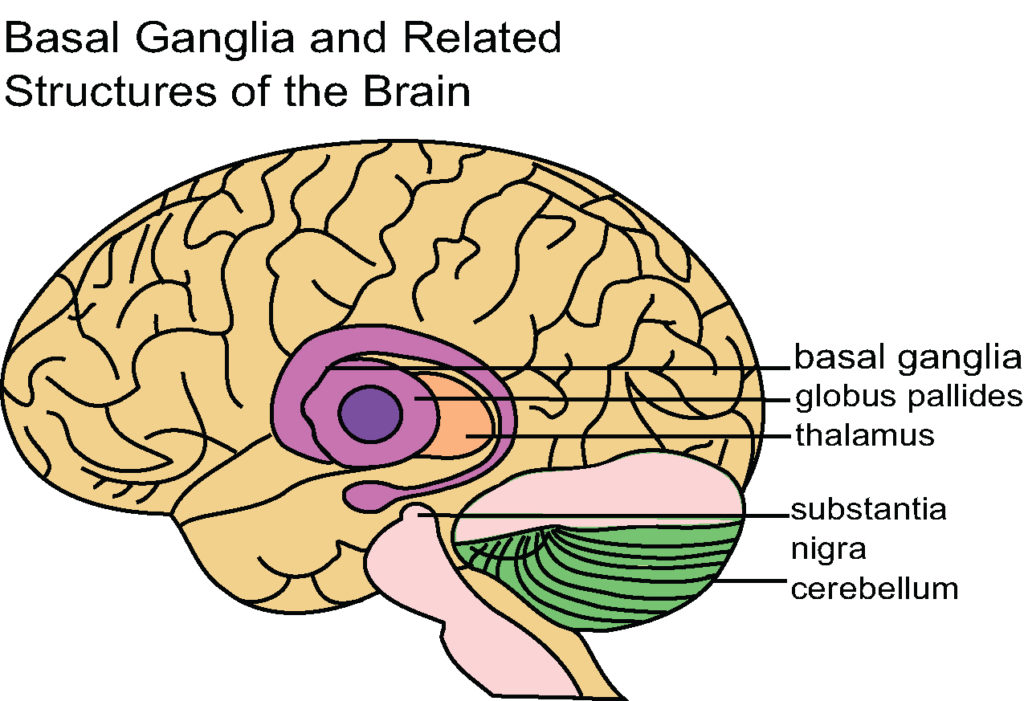11.7D: Basal Ganglia
- Page ID
- 7636
The basal ganglia is important for the control of movement and forming habits, and each of its components has a complex internal anatomical and neurochemical organization.
LEARNING OBJECTIVE
Describe the functions of the basal ganglia
Key Takeaways
Key Points
- The basal ganglia are a group of nuclei of varied origin in the brains of vertebrates that act as a cohesive functional unit.
- The basal ganglia are associated with a variety of functions including voluntary motor control, procedural learning relating to routine behaviors or “habits” such as bruxism, eye movements, cognitive, and emotional functions.
- The basal ganglia are composed of the striatum, the pallidum, the substantia nigra, and the subthalamic nucleus.
- The basal ganglia play a central role in a number of neurological conditions including Parkinson’s disease and Huntington’s disease.
Key Terms
- Huntington’s disease: A neurodegenerative genetic disorder that affects muscle coordination and leads to cognitive decline and psychiatric problems.
- Parkinson’s disease: A chronic neurological disorder resulting in lack of control over movement; poor balance and coordination; and similar symptoms.
- executive functions: Also known as cognitive control and supervisory attentional system. Refers to a set of cognitive processes, including attentional control, inhibitory control, working memory, and cognitive flexibility, reasoning, problem solving, and planning.
- bruxism: Excessive grinding and clenching of the teeth.
The basal ganglia (or basal nuclei) are a group of nuclei of varied origin in the brains of vertebrates that act as a cohesive functional unit. They are situated at the base of the forebrain and are strongly connected with the cerebral cortex, thalamus, and other brain areas. The components of the basal ganglia include the striatum, pallidum, substantia nigra, and subthalamic nucleus. Each of these components has a complex internal anatomical and neurochemical organization.
Structure

The Basal Ganglia: The basal nuclei are often referred to as the basal ganglia. The main components of the basal nuclei are labeled in purple.
The main components of the basal ganglia are:
- Striatum, or neostriatum: This component consists of 3 divisions: the caudate, putamen, and ventral striatum (includes the nucleus accumbens). The striatum receives input from many brain areas, but sends output only to other components of the basal ganglia.
- Globus pallidus, or pallidum: This component is composed of the globus pallidus externa (GPe) and globus pallidus interna (GPi). The pallidum receives its most important input from the striatum (either directly or indirectly), and sends inhibitory output to a number of motor-related areas, including the part of the thalamus that projects to the motor-related areas of the cortex.
- Substantia nigra: This component consists of the substantia nigra pars compacta (SNc) and substantia nigra pars reticulata (SNr). The SNr functions similarly to the pallidum, and the SNc cells contain neuromelanin and produce dopamine (a neurotransmitter) for input to the striatum.
- Subthalamic nucleus (STN): The STN receives input mainly from the striatum and cortex, and projects to a portion of the pallidum (interna portion or GPi). It is the only portion of the ganglia that produces an excitatory neurotransmitter, glutamate. The role of the subthalamic nucleus is to stimulate the SNr-GPi complex, and it receives inhibitory input from the GPe and sends excitatory signal to the GPi.
Function
The basal ganglia are associated with a variety of functions, including voluntary motor control, procedural learning relating to routine behaviors or habits such as bruxism, eye movements, and cognitive, emotional functions. Currently, popular theories implicate the basal ganglia primarily in action selection, that is, the decision of which several possible behaviors to execute at a given time. Experimental studies show that the basal ganglia exert an inhibitory influence on a number of motor systems and that a release of this inhibition permits a motor system to become active. The behavior switching that takes place within the basal ganglia is influenced by signals from many parts of the brain, including the prefrontal cortex, which plays a key role in executive functions.
The basal ganglia play a central role in a number of neurological conditions, including several movement disorders. The most notable are Parkinson’s disease, which involves degeneration of the melanin-pigmented dopamine-producing cells in the substantia nigra pars compacta (SNc), and Huntington’s disease, which primarily involves damage to the striatum. Basal ganglia dysfunction is also implicated in some other disorders of behavior control such as Tourette’s syndrome, ballismus (particularly hemibalismus), obsessive-compulsive disorder, and Wilson’s disease (hepatolenticular degeneration). With the exception of Wilson’s disease and hemiballismus, the neuropathological mechanisms underlying diseases of ganglia such as Parkinsons’ and Huntington’s are not very well understood or are at best still developing theories.
The basal ganglia have a limbic sector whose components are the nucleus accumbens, ventral pallidum, and ventral tegmental area (VTA). This limbic sector is thought to play a central role in reward learning, particularly a pathway from the VTA to the nucleus accumbens that uses the neurotransmitter dopamine. A number of highly addictive drugs, including cocaine, amphetamine, and nicotine, are thought to work by increasing the efficacy of this dopamine signal.

